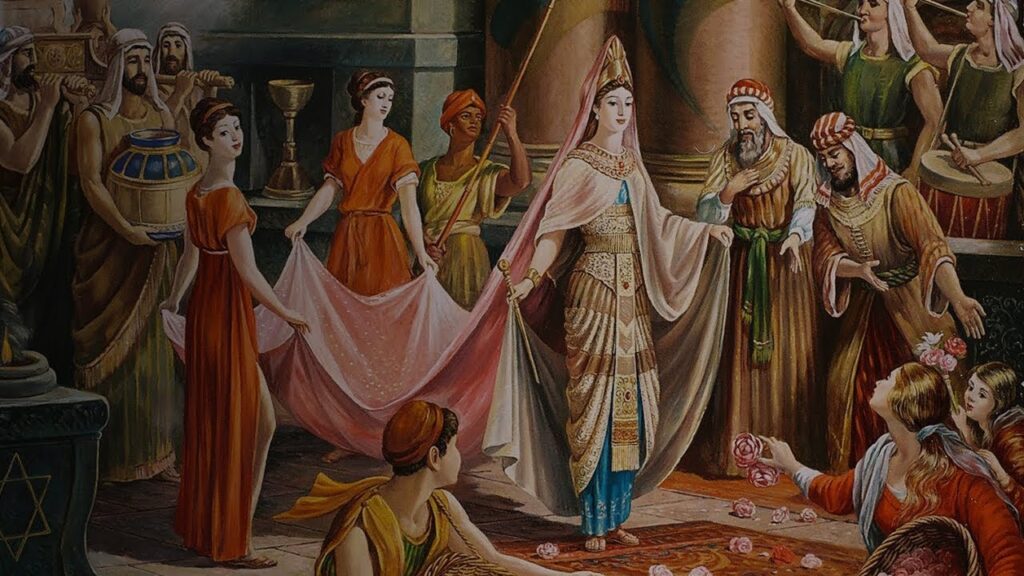The story of Solomon and the Queen of Sheba is a fascinating tale that appears in religious texts, folklore, and literature across different cultures. Below is a summary of the most well-known versions of the story, primarily drawn from the Hebrew Bible, the Quran, and Ethiopian tradition.
The Biblical Account (Hebrew Bible)
The story of Solomon and the Queen of Sheba is found in the First Book of Kings (1 Kings 10:1-13) and the Second Book of Chronicles (2 Chronicles 9:1-12) in the Hebrew Bible.
- The Queen’s Visit:
- The Queen of Sheba, hearing of King Solomon’s wisdom and wealth, travels to Jerusalem to test him with difficult questions and riddles. She brings a large caravan of gifts, including gold, spices, and precious stones.
- Solomon answers all her questions, impressing her with his wisdom, the grandeur of his court, and the organization of his kingdom.
- Mutual Admiration:
- The Queen of Sheba acknowledges Solomon’s wisdom and praises the God of Israel for blessing him. She declares that his wisdom and prosperity exceed even the reports she had heard.
- Solomon, in turn, gives her gifts, and she returns to her homeland.
The biblical account does not mention any romantic relationship between Solomon and the Queen of Sheba, focusing instead on their exchange of wisdom and wealth.
The Quranic Account
The Quran also mentions the Queen of Sheba (called Bilqis in Islamic tradition) in Surah An-Naml (27:20-44).
- The Hoopoe’s Discovery:
- Solomon, a prophet and king, sends a hoopoe bird to search for water. The bird returns with news of a powerful queen ruling over a wealthy kingdom called Sheba, who worships the sun instead of God.
- Solomon sends a letter to the Queen of Sheba, inviting her to submit to God.
- The Queen’s Response:
- The Queen consults her advisors and decides to send gifts to Solomon. However, Solomon rejects the gifts, insisting that she come to him in submission to God.
- The Queen travels to Solomon’s court, where she is tested by a glass floor that she mistakes for water. She lifts her skirts to avoid wetting them, revealing her legs, and realizes her mistake.
- Conversion to Islam:
- The Queen acknowledges Solomon’s wisdom and the power of God, renouncing her worship of the sun and embracing monotheism.
Ethiopian Tradition (Kebra Nagast)
The Kebra Nagast (“The Glory of Kings”), an Ethiopian epic, provides a more elaborate and romanticized version of the story.
- The Queen’s Journey:
- The Queen of Sheba (called Makeda in Ethiopian tradition) travels to Jerusalem to meet Solomon, drawn by his wisdom and fame.
- Solomon hosts her and tests her with riddles, which she answers successfully.
- Romantic Relationship:
- Solomon and Makeda develop a close relationship. One night, Solomon tricks Makeda into sharing his bed by making her promise not to take anything from his house without permission. He then serves her salty food, and when she drinks water during the night, he claims she has broken her promise.
- As a result, they spend the night together, and Makeda becomes pregnant.
- Birth of Menelik:
- Makeda returns to Sheba and gives birth to a son, Menelik I, who is said to be the founder of the Solomonic dynasty of Ethiopia.
- When Menelik grows up, he visits Solomon in Jerusalem. Solomon tries to convince him to stay, but Menelik returns to Ethiopia with the Ark of the Covenant, which he allegedly takes from Jerusalem.
Themes and Interpretations
The story of Solomon and the Queen of Sheba has been interpreted in various ways across cultures:
- Wisdom and Power: The story highlights Solomon’s wisdom and the Queen’s intelligence, emphasizing the exchange of knowledge and mutual respect.
- Spiritual Conversion: In Islamic and Ethiopian traditions, the story underscores the Queen’s journey from polytheism to monotheism.
- Romance and Legacy: Ethiopian tradition adds a romantic and dynastic element, linking the Queen of Sheba to the founding of Ethiopia’s royal lineage.
Cultural Impact
The tale of Solomon and the Queen of Sheba has inspired countless works of art, literature, and music. It remains a symbol of cross-cultural exchange, wisdom, and the meeting of two great civilizations.
Let me know if you’d like more details about any specific version or cultural interpretation!

